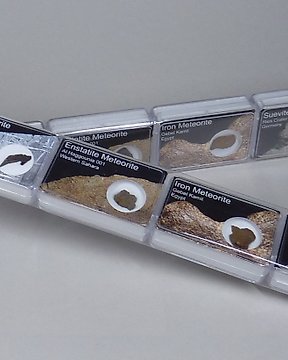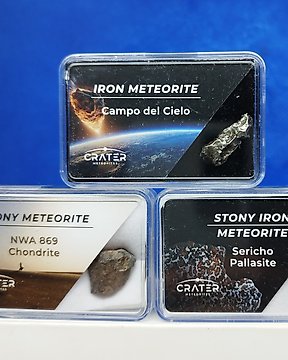No surpises. A great addition to my collection!
View translationAncient Roman Glass Plaque. 1st - 2nd century AD. 3.8 cm length. (No Reserve Price)
No. 88397283





Plaque.
Ancient Roman, 1st - 2nd century AD.
MATERIAL: Glass
SIZE: 3.8 cm length.
PROVENANCE: Private collection of the French artist Clément Massier (1844 - 1917). In the family since then.
CONDITION: Good condition.
DESCRIPTION:
Big and small sized bottles of various shapes (more or less globular body, tall or low flared neck, ribbed or plain handles, etc.) and blown in different colors (aubergine, blue, yellow, transparent, green, etc.) were very popular from the 1st to the 4th century A.D.: they were part of the most frequently used toiletry tools. Their success certainly encouraged glassworkers to be highly inventive in order to create new versions, even more attractive to the public.
Towards the end of the Hellenistic period, glass definitely supplanted terracotta as a raw material for the manufacture of containers in all areas of daily life: this event, which occurred gradually, shall be regarded as a major technical revolution in antiquity, made easier, in early Roman times, by the invention and quick spread of the blowpipe, and by the conception of furnaces resisting to higher and higher temperatures.
With a versatility like no other known material in Roman times, abundant availability, lightness and ease of use, glass enabled the imitation of a wide range of other materials (especially precious metals), whether in the form, the design or the color. Furthermore, the ancients certainly knew that glass is a chemically neutral substance, what makes it particularly suitable for the storage of cosmetics or pharmaceutical products, as well as food and liquids.
Just about all Roman burials contain clear or greenish glass vessels covered with an iridescent patina due to the action of humidity and air. These flasks, when made in narrow forms, are often called unguentaria or lacrimaria by collectors, but were only used to contain oils and perfumes in the tombs, not to be containers for tears.
The Romans also perfected the art of working figures in relief on the glass vessels with the addition of another layer of glass of a different colour, or one of enamel, along with moulding, cutting or engraving of the glass, with the result that the surfaces of the containers looked like worked cameos.
BIBLIOGRAPHY:
- ARVEILLER-DULONG, Véronique. NENNA, Marie-Dominique. Les verres antiques au museé du Louvre. Tomo II. Museé du Louvre. 2006.
- FLEMING, Stuart J. Roman Glass: Reflections on Cultural Change. University of Pennsylvania Museum of Archaeology and Anthropology. 1999.
Notes:
- The piece includes authenticity certificate.
- The piece includes Spanish Export License (Passport for European Union) - If the piece is destined outside the European Union a substitution of the export permit should be requested, can take between 1-2 weeks maximum.
- The seller guarantees that he acquired this piece according to all national and international laws related to the ownership of cultural property. Provenance statement seen by Catawiki.
Seller's Story
Plaque.
Ancient Roman, 1st - 2nd century AD.
MATERIAL: Glass
SIZE: 3.8 cm length.
PROVENANCE: Private collection of the French artist Clément Massier (1844 - 1917). In the family since then.
CONDITION: Good condition.
DESCRIPTION:
Big and small sized bottles of various shapes (more or less globular body, tall or low flared neck, ribbed or plain handles, etc.) and blown in different colors (aubergine, blue, yellow, transparent, green, etc.) were very popular from the 1st to the 4th century A.D.: they were part of the most frequently used toiletry tools. Their success certainly encouraged glassworkers to be highly inventive in order to create new versions, even more attractive to the public.
Towards the end of the Hellenistic period, glass definitely supplanted terracotta as a raw material for the manufacture of containers in all areas of daily life: this event, which occurred gradually, shall be regarded as a major technical revolution in antiquity, made easier, in early Roman times, by the invention and quick spread of the blowpipe, and by the conception of furnaces resisting to higher and higher temperatures.
With a versatility like no other known material in Roman times, abundant availability, lightness and ease of use, glass enabled the imitation of a wide range of other materials (especially precious metals), whether in the form, the design or the color. Furthermore, the ancients certainly knew that glass is a chemically neutral substance, what makes it particularly suitable for the storage of cosmetics or pharmaceutical products, as well as food and liquids.
Just about all Roman burials contain clear or greenish glass vessels covered with an iridescent patina due to the action of humidity and air. These flasks, when made in narrow forms, are often called unguentaria or lacrimaria by collectors, but were only used to contain oils and perfumes in the tombs, not to be containers for tears.
The Romans also perfected the art of working figures in relief on the glass vessels with the addition of another layer of glass of a different colour, or one of enamel, along with moulding, cutting or engraving of the glass, with the result that the surfaces of the containers looked like worked cameos.
BIBLIOGRAPHY:
- ARVEILLER-DULONG, Véronique. NENNA, Marie-Dominique. Les verres antiques au museé du Louvre. Tomo II. Museé du Louvre. 2006.
- FLEMING, Stuart J. Roman Glass: Reflections on Cultural Change. University of Pennsylvania Museum of Archaeology and Anthropology. 1999.
Notes:
- The piece includes authenticity certificate.
- The piece includes Spanish Export License (Passport for European Union) - If the piece is destined outside the European Union a substitution of the export permit should be requested, can take between 1-2 weeks maximum.
- The seller guarantees that he acquired this piece according to all national and international laws related to the ownership of cultural property. Provenance statement seen by Catawiki.
Seller's Story
- 833
- 9
- 1
Very fine article. Thanks.
View translationMost satisfying as usual. Highly recommended. :)
View translationTodo perfecto, trato muy profesional
View translationThank you very much Mr Bagot. The piece is excellent, very nice and arrived in perfect condition. Excellent packaging and only 36 hours to arrive home in Paris. All is perfect. Thks. Gilles Gamond.
View translationComme a son habitude,j. Bagot propose des artefacts de qualité 👍👍
View translationtop 💯💯💯💯💯💯💯💯💯💯💯💯💯💯 come sempre grazie :-)
View translationPerfect !
View translationWonderful, unique object, very nice and personal contact, super packed, fast shipping, simply everything perfect, thank you very much!
View translationtodo bien, bien empacado y envío rápido.
View translationGrazie per la cura e il tempismo della spedizione, grazie per la vostra professionalità.
View translationmuy contento con la compra y el envío, rápido y seguro, como merecen las 4 piezas históricas que adquirí, con toda su documentación, vendedor muy muy recomendable, un placer
View translationoggetto imballato perfettamente e con tutti i documenti legali necessari alla vendita. È monotono 😀 😃 ma acquistare dalle ditte che collaborano con catawiki è sempre una sicurezza ed un piacere
View translationTutto bene
View translationIt's always a pleasure. Until next time. Thank you.
View translationHappy with the purchase, the order arrived intact. Item is in good condition, and advertised, everything went great
View translationEverything was perfect! thank you regards
View translationExcelente vendedor. Todo muy bien. El envío muy rápido. Recomendable. Muchas gracias
View translationvery good as always
View translationTrès beaux objets de qualité avec certificats d'authenticité et explications.vendeur au Top. Merci
View translationbellissimoooooo grazie top 💯💯💯 come sempre
View translationGreat purchase! Very well packaged; arrived very fast with all the necessary paperwork. Thank you!
View translationTodo bien y rápido. Embalaje perfecto.
View translationVendeur réactif. Délai de livraison respecté . Merci! Monique
View translationTutto perfetto.
View translation- 833
- 9
- 1
No surpises. A great addition to my collection!
View translationDisclaimer
The seller guarantees and can prove that the object was obtained legally. The seller was informed by Catawiki that they had to provide the documentation required by the laws and regulations in their country of residence. The seller guarantees and is entitled to sell/export this object. The seller will provide all provenance information known about the object to the buyer. The seller ensures that any necessary permits are/will be arranged. The seller will inform the buyer immediately about any delays in obtaining such permits.
The seller guarantees and can prove that the object was obtained legally. The seller was informed by Catawiki that they had to provide the documentation required by the laws and regulations in their country of residence. The seller guarantees and is entitled to sell/export this object. The seller will provide all provenance information known about the object to the buyer. The seller ensures that any necessary permits are/will be arranged. The seller will inform the buyer immediately about any delays in obtaining such permits.









